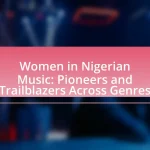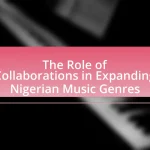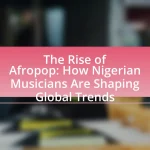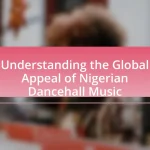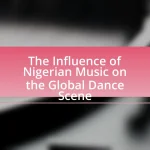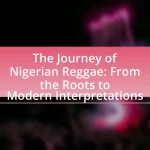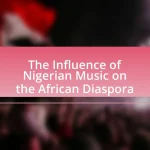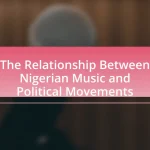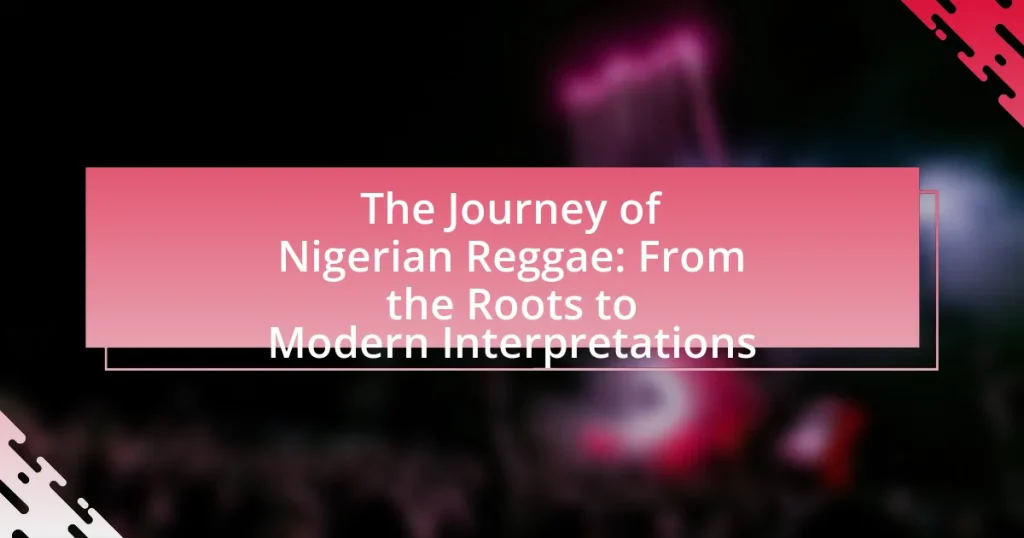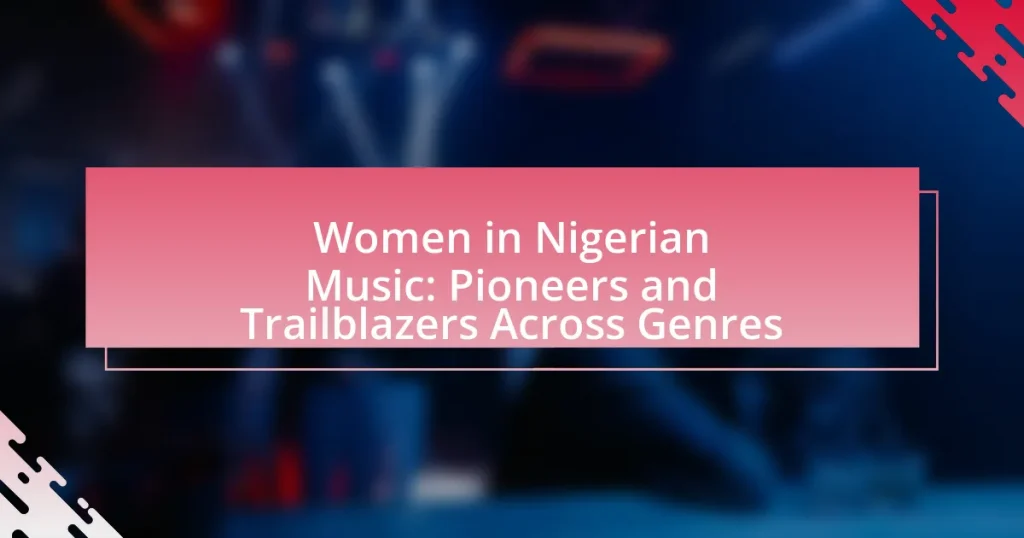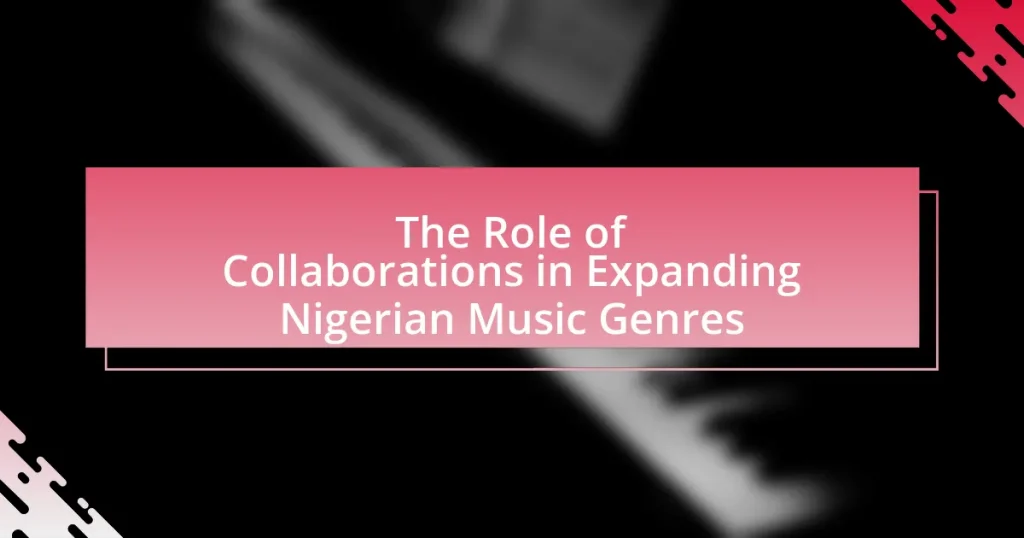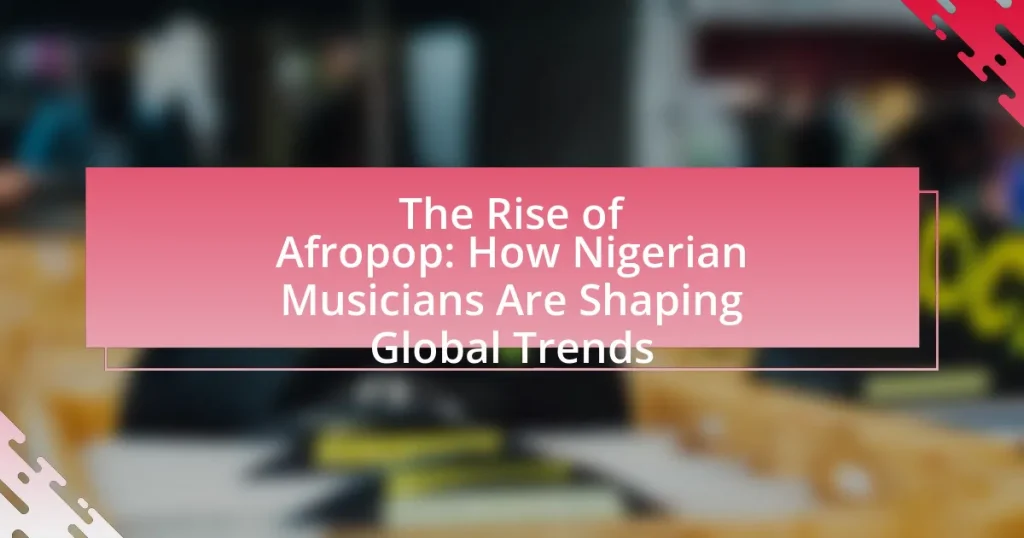The article examines the evolution of Nigerian reggae music, tracing its origins from the late 1970s to contemporary interpretations. It highlights the genre’s emergence influenced by Jamaican reggae and local musical traditions, with key artists such as Majek Fashek and Ras Kimono playing pivotal roles in its development. The article discusses the socio-political factors that shaped reggae themes in Nigeria, the fusion of reggae with other genres like Afrobeat and hip-hop, and the impact of technological advancements on music production. Additionally, it explores the global recognition of Nigerian reggae artists and the cultural significance of their work in addressing local issues.
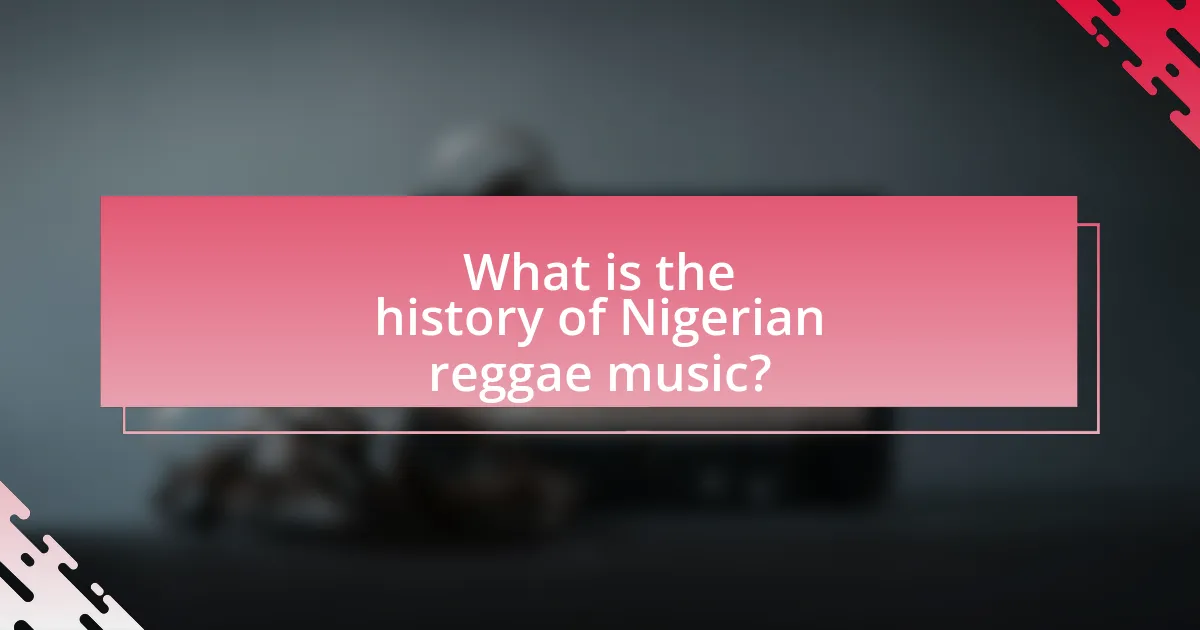
What is the history of Nigerian reggae music?
Nigerian reggae music emerged in the late 1970s, influenced by the global reggae movement and local musical traditions. The genre gained popularity through artists like Majek Fashek and Ras Kimono, who infused reggae with Nigerian sounds and themes, addressing social issues and cultural identity. By the 1980s, reggae became a significant part of Nigeria’s music scene, with festivals and radio stations promoting the genre. The 1990s saw a diversification of reggae styles, incorporating elements of hip-hop and Afrobeat, leading to a contemporary resurgence in the 2000s with artists like Patoranking and Burna Boy, who continue to blend reggae with modern genres while maintaining its roots in social commentary.
How did reggae music first arrive in Nigeria?
Reggae music first arrived in Nigeria in the late 1960s, primarily through the influence of returning Nigerian expatriates and the exposure to international music via radio and records. The genre gained traction as artists like Bob Marley became popular, leading to the emergence of local reggae bands that incorporated traditional Nigerian sounds. This cultural exchange facilitated the integration of reggae into Nigeria’s diverse musical landscape, establishing a foundation for its growth in the country.
What influences shaped the early Nigerian reggae scene?
The early Nigerian reggae scene was shaped primarily by the influence of Jamaican reggae music, which introduced themes of social justice and resistance. This genre resonated with Nigeria’s socio-political climate during the 1970s, particularly the struggles against military rule and corruption. Additionally, local musical traditions, such as highlife and juju, blended with reggae rhythms, creating a unique sound that appealed to Nigerian audiences. The arrival of influential artists like Majek Fashek and the popularity of reggae music on radio stations further solidified its presence in Nigeria, demonstrating the genre’s ability to address local issues while maintaining its roots in Jamaican culture.
Who were the pioneering artists in Nigerian reggae?
The pioneering artists in Nigerian reggae include Ras Kimono, Majek Fashek, and Oritz Wiliki. Ras Kimono, known for his hit “Under Pressure,” played a significant role in popularizing reggae in Nigeria during the late 1980s. Majek Fashek, often referred to as the “Rainmaker,” gained international acclaim with his song “Send Down the Rain,” which showcased reggae’s influence on Nigerian music. Oritz Wiliki contributed to the genre with his unique style and socially conscious lyrics, further establishing reggae’s presence in Nigeria. These artists laid the foundation for the growth and evolution of reggae music in the country.
What role did socio-political factors play in the development of Nigerian reggae?
Socio-political factors significantly influenced the development of Nigerian reggae by shaping its themes and messages. The genre emerged during a period of political unrest and social change in Nigeria, particularly in the 1970s and 1980s, when issues such as military dictatorship, corruption, and economic hardship were prevalent. Artists like Majek Fashek and Ras Kimono used reggae to address these socio-political issues, promoting messages of resistance and social justice. The popularity of reggae in Nigeria was further fueled by the global influence of Jamaican reggae, which resonated with local struggles, creating a unique blend that reflected both international and domestic concerns. This connection between socio-political realities and musical expression solidified reggae’s role as a voice for the marginalized in Nigerian society.
How did the Nigerian civil unrest influence reggae music themes?
The Nigerian civil unrest significantly influenced reggae music themes by introducing elements of social justice, resistance, and political awareness. Artists began to incorporate lyrics that addressed the struggles against oppression, corruption, and inequality, reflecting the turbulent socio-political landscape of Nigeria during the civil unrest of the late 20th century. For instance, musicians like Majek Fashek and Ras Kimono used their platforms to voice the frustrations of the populace, drawing parallels between their experiences and the broader themes of struggle found in classic reggae music from Jamaica. This connection not only enriched the lyrical content of Nigerian reggae but also established a cultural dialogue that resonated with listeners facing similar challenges.
What messages did early Nigerian reggae artists convey through their music?
Early Nigerian reggae artists conveyed messages of social justice, unity, and cultural identity through their music. These artists often addressed issues such as political oppression, economic hardship, and the importance of community solidarity. For instance, songs by artists like Ras Kimono and Majek Fashek highlighted the struggles against corruption and the need for societal change, reflecting the socio-political climate of Nigeria in the 1980s. Their lyrics served as a form of protest and a call for awareness, resonating with the experiences of many Nigerians during that era.
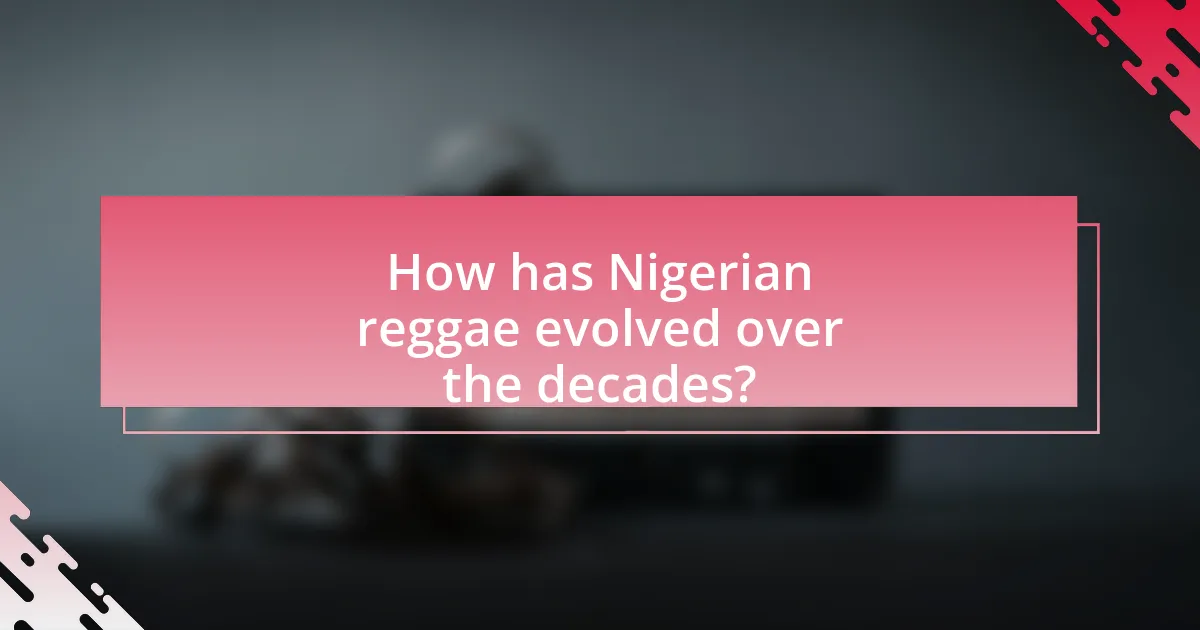
How has Nigerian reggae evolved over the decades?
Nigerian reggae has evolved significantly over the decades, transitioning from its roots in the 1970s to a diverse contemporary scene. Initially influenced by Jamaican reggae, Nigerian artists like Majek Fashek and Ras Kimono incorporated local themes and languages, creating a unique sound that resonated with the Nigerian populace. By the 1980s and 1990s, reggae music in Nigeria began to blend with other genres such as Afrobeat and hip-hop, leading to a fusion that expanded its appeal. This evolution continued into the 2000s and 2010s, where artists like Patoranking and Burna Boy further integrated reggae elements into mainstream music, showcasing the genre’s adaptability and relevance in modern Nigerian culture. The growth of digital platforms has also facilitated the global reach of Nigerian reggae, allowing it to influence and be influenced by international trends.
What are the key phases in the evolution of Nigerian reggae?
The key phases in the evolution of Nigerian reggae include the introduction of reggae in the late 1970s, the rise of local artists in the 1980s, the fusion with traditional Nigerian music in the 1990s, and the contemporary adaptations in the 2000s. In the late 1970s, reggae music was introduced to Nigeria primarily through radio and records, influencing musicians like Majek Fashek. The 1980s saw the emergence of local reggae stars such as Ras Kimono and Orits Wiliki, who popularized the genre. In the 1990s, Nigerian reggae began to incorporate indigenous sounds and themes, leading to a unique fusion that resonated with local audiences. By the 2000s, reggae in Nigeria evolved further, blending with hip-hop and dancehall, showcasing the genre’s adaptability and continued relevance in the music scene.
How did the 1980s and 1990s shape the reggae landscape in Nigeria?
The 1980s and 1990s significantly shaped the reggae landscape in Nigeria by introducing a fusion of local musical styles with traditional reggae rhythms, leading to the emergence of unique subgenres. During this period, Nigerian artists began to incorporate elements of highlife, juju, and Afrobeat into reggae, creating a distinct sound that resonated with local audiences. Notable figures such as Majek Fashek and Ras Kimono gained prominence, with their music addressing social issues and political themes relevant to Nigeria at the time. The rise of cassette culture facilitated the widespread distribution of reggae music, allowing it to reach a broader audience and influence the youth culture in Nigeria. This era also saw the establishment of reggae festivals and events, further solidifying reggae’s place in the Nigerian music scene.
What technological advancements impacted the production of Nigerian reggae music?
Technological advancements such as digital audio workstations (DAWs), affordable recording equipment, and the internet significantly impacted the production of Nigerian reggae music. The introduction of DAWs like Pro Tools and FL Studio allowed artists to produce high-quality music from home studios, reducing the need for expensive studio time. Additionally, the availability of affordable recording equipment enabled more musicians to create and distribute their work independently. The internet facilitated the sharing and promotion of reggae music, allowing Nigerian artists to reach global audiences and collaborate with international musicians, thereby enriching the genre.
What are the contemporary trends in Nigerian reggae music?
Contemporary trends in Nigerian reggae music include the fusion of traditional reggae rhythms with Afrobeat and hip-hop elements, creating a unique sound that resonates with younger audiences. Artists like Burna Boy and Patoranking exemplify this trend, incorporating reggae influences into their music while addressing social issues and personal experiences. The rise of digital platforms has also facilitated the global reach of Nigerian reggae, allowing artists to connect with international audiences and collaborate with global reggae stars. This evolution reflects a broader trend of genre blending and cultural exchange within the Nigerian music scene.
How are modern artists blending reggae with other genres?
Modern artists are blending reggae with other genres by incorporating elements of hip-hop, dancehall, and Afrobeats into their music. This fusion is evident in the works of Nigerian artists like Burna Boy and Wizkid, who seamlessly integrate reggae rhythms and melodies with contemporary beats and lyrical styles. For instance, Burna Boy’s album “African Giant” features reggae influences alongside Afrobeats and dancehall, showcasing a diverse sound that appeals to a global audience. This blending not only revitalizes reggae but also expands its reach, allowing it to resonate with listeners from various musical backgrounds.
What role do social media and streaming platforms play in the promotion of Nigerian reggae?
Social media and streaming platforms significantly enhance the promotion of Nigerian reggae by providing artists with direct access to a global audience. These platforms enable musicians to share their music, engage with fans, and build a community around their work, which is crucial for genre visibility. For instance, platforms like Instagram and TikTok allow artists to showcase their performances and connect with listeners through interactive content, while streaming services such as Spotify and Apple Music facilitate easy access to their music, increasing streaming numbers and chart placements. This digital presence has led to a rise in the popularity of Nigerian reggae, evidenced by the growing number of playlists dedicated to the genre and collaborations with international artists, further solidifying its place in the global music scene.
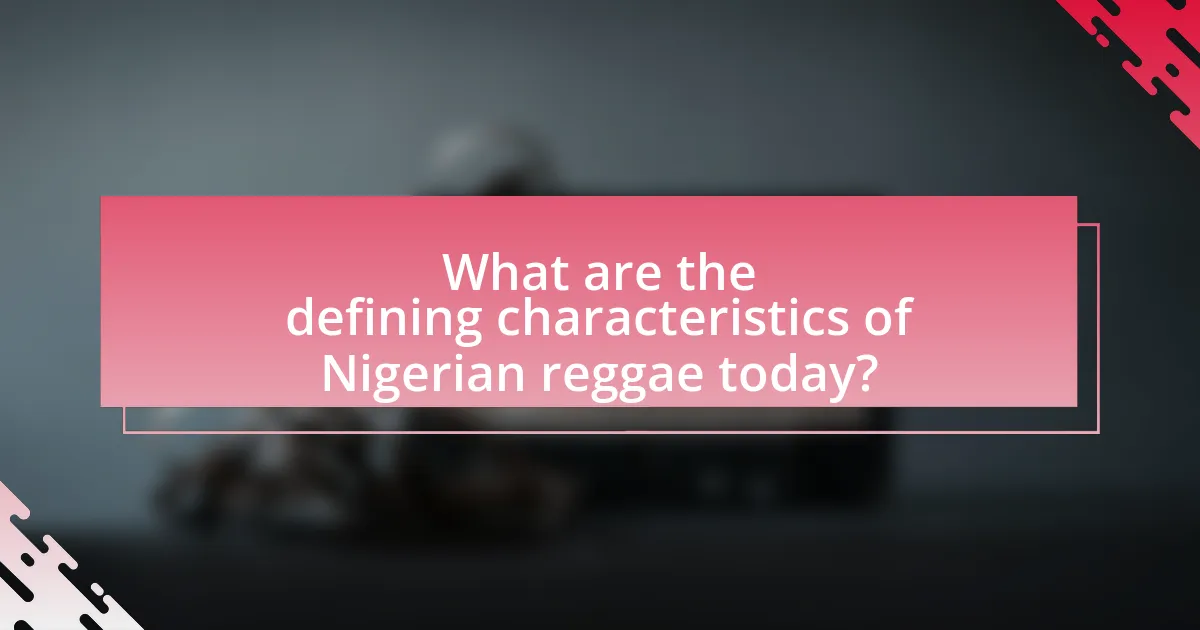
What are the defining characteristics of Nigerian reggae today?
Nigerian reggae today is characterized by a fusion of traditional reggae rhythms with local musical styles, social and political themes, and a growing influence of Afrobeat elements. This genre reflects the cultural diversity of Nigeria, incorporating indigenous languages and instruments, which enhances its relatability and appeal to the local audience. Additionally, contemporary Nigerian reggae artists often address pressing social issues such as corruption, inequality, and youth empowerment, mirroring the genre’s roots in activism. The rise of digital platforms has also facilitated the global reach of Nigerian reggae, allowing artists to connect with international audiences while maintaining their unique cultural identity.
How does Nigerian reggae differ from its Jamaican counterpart?
Nigerian reggae differs from its Jamaican counterpart primarily in its incorporation of local musical styles and cultural themes. While Jamaican reggae is deeply rooted in Rastafarian culture and often addresses social and political issues specific to Jamaica, Nigerian reggae blends reggae rhythms with Afrobeat, highlife, and traditional Nigerian sounds, creating a unique fusion. This fusion reflects Nigeria’s diverse cultural landscape and often emphasizes themes relevant to Nigerian society, such as unity, love, and resilience, rather than the predominantly Rastafarian themes found in Jamaican reggae. Additionally, Nigerian reggae artists like Majek Fashek and Oritsefemi have contributed to this distinct sound by infusing local languages and dialects into their lyrics, further differentiating it from Jamaican reggae.
What unique cultural elements are incorporated into Nigerian reggae music?
Nigerian reggae music incorporates unique cultural elements such as indigenous rhythms, local languages, and themes of social justice and spirituality. The fusion of traditional African musical styles, like highlife and juju, with reggae’s characteristic offbeat guitar and bass lines creates a distinctive sound. Artists often use Nigerian Pidgin and local dialects in their lyrics, making the music relatable to the local audience. Additionally, the focus on social issues, such as corruption and inequality, reflects the socio-political landscape of Nigeria, resonating with listeners and reinforcing the genre’s cultural relevance.
How do lyrics in Nigerian reggae reflect local issues and experiences?
Lyrics in Nigerian reggae reflect local issues and experiences by addressing themes such as socio-political struggles, economic hardship, and cultural identity. For instance, artists like Majek Fashek and Oritsefemi often incorporate commentary on government corruption, social injustice, and the impact of colonial history on contemporary Nigerian society. These lyrics resonate with listeners who face similar challenges, making the music a powerful medium for social commentary and collective expression. The incorporation of local languages and proverbs further enhances the relatability of the messages, grounding them in the everyday realities of Nigerian life.
What impact does Nigerian reggae have on the global music scene?
Nigerian reggae significantly influences the global music scene by blending traditional African rhythms with reggae’s distinctive sound, creating a unique genre that resonates worldwide. This fusion has led to the emergence of artists like Majek Fashek and Ras Kimono, who have gained international recognition, showcasing the cultural richness of Nigeria. The global appeal of Nigerian reggae is evidenced by its incorporation into various music festivals and collaborations with international artists, further expanding its reach and impact. Additionally, the genre has contributed to the global dialogue on social issues, as many Nigerian reggae songs address themes of unity, resistance, and empowerment, aligning with reggae’s historical roots in activism.
How are Nigerian reggae artists gaining international recognition?
Nigerian reggae artists are gaining international recognition through a combination of unique musical styles, collaborations with global artists, and the use of digital platforms for distribution. The distinct fusion of traditional Nigerian sounds with reggae rhythms has attracted a diverse audience, enhancing their appeal beyond local borders. Collaborations with internationally recognized artists, such as Burna Boy and Wizkid, have further elevated their profiles, showcasing their talent on global stages. Additionally, the rise of streaming services like Spotify and Apple Music has enabled Nigerian reggae artists to reach international listeners, significantly increasing their visibility and fan base.
What collaborations are emerging between Nigerian reggae artists and international musicians?
Emerging collaborations between Nigerian reggae artists and international musicians include partnerships such as Burna Boy’s work with Jamaican artist Protoje and the collaboration between Nigerian reggae artist Patoranking and American musician Kranium. These collaborations highlight the blending of reggae with Afrobeat and dancehall influences, showcasing the global appeal of Nigerian reggae. For instance, Burna Boy’s track “Twice as Tall” features reggae elements and has gained international recognition, while Patoranking’s “Wilmer” includes contributions from Kranium, further bridging the gap between Nigerian and Jamaican music scenes.
What are some practical tips for exploring Nigerian reggae music?
To explore Nigerian reggae music, start by listening to key artists such as Majek Fashek, Ras Kimono, and Oritsefemi, who have significantly influenced the genre in Nigeria. Engaging with their music provides insight into the unique blend of reggae with local sounds and themes. Attend live performances and reggae festivals in Nigeria, such as the Lagos Reggae Festival, to experience the vibrant culture and community surrounding the genre. Additionally, follow Nigerian reggae playlists on streaming platforms to discover both classic and contemporary tracks, which showcase the evolution of reggae in Nigeria. Researching the historical context of reggae’s introduction to Nigeria in the 1970s, particularly through the influence of Jamaican music, will deepen your understanding of its cultural significance.
